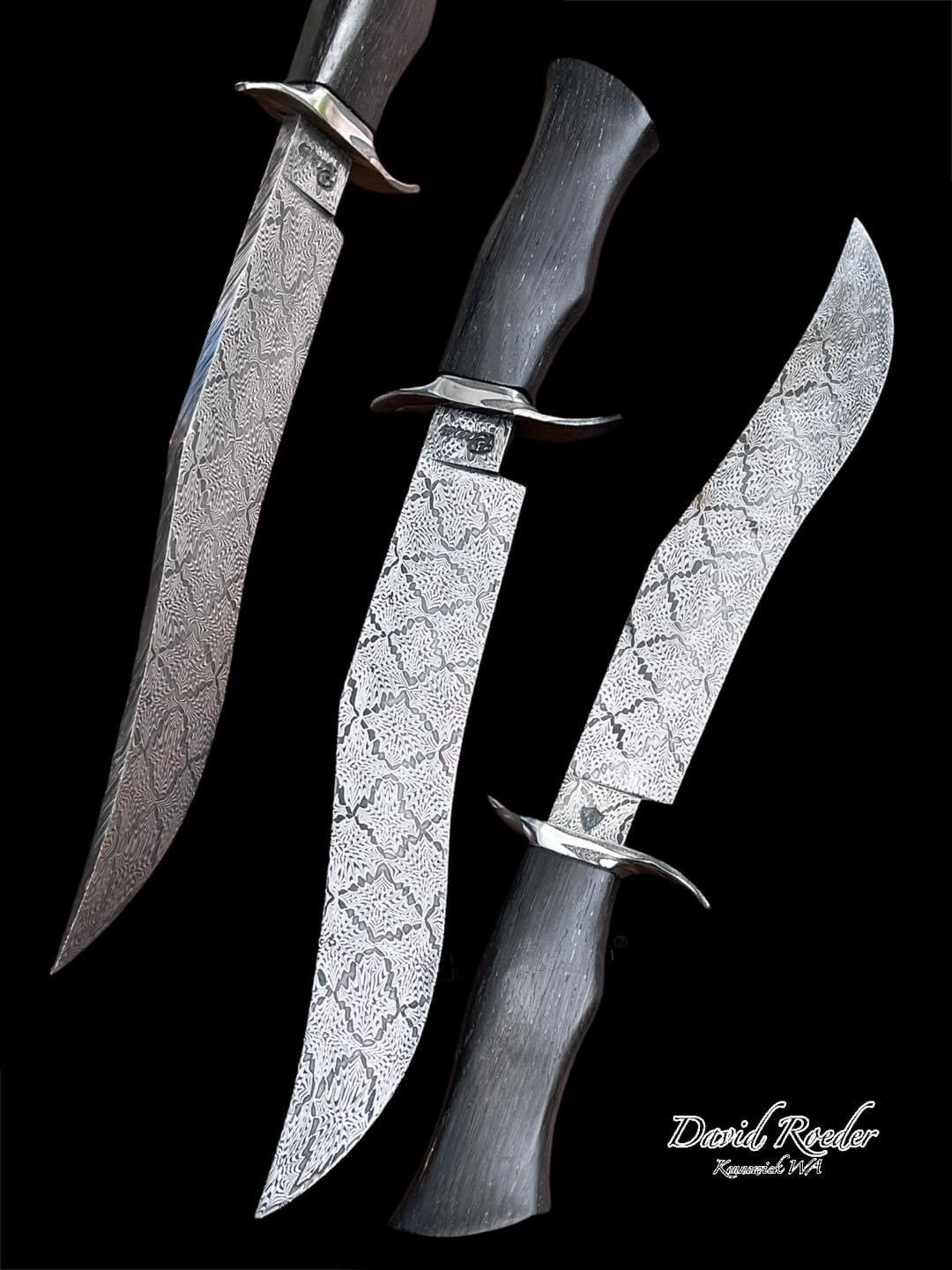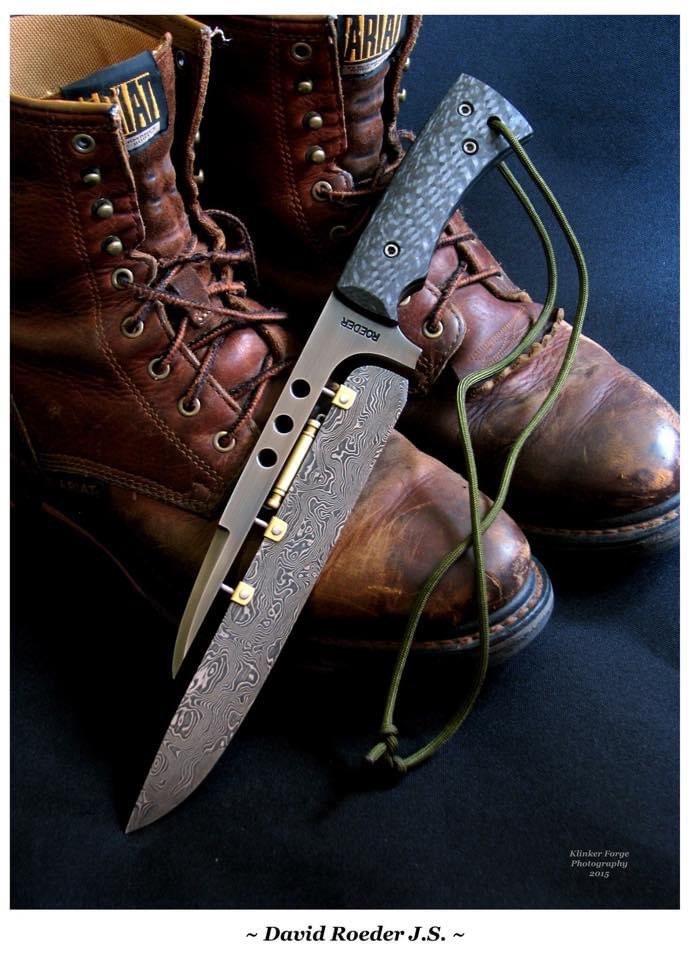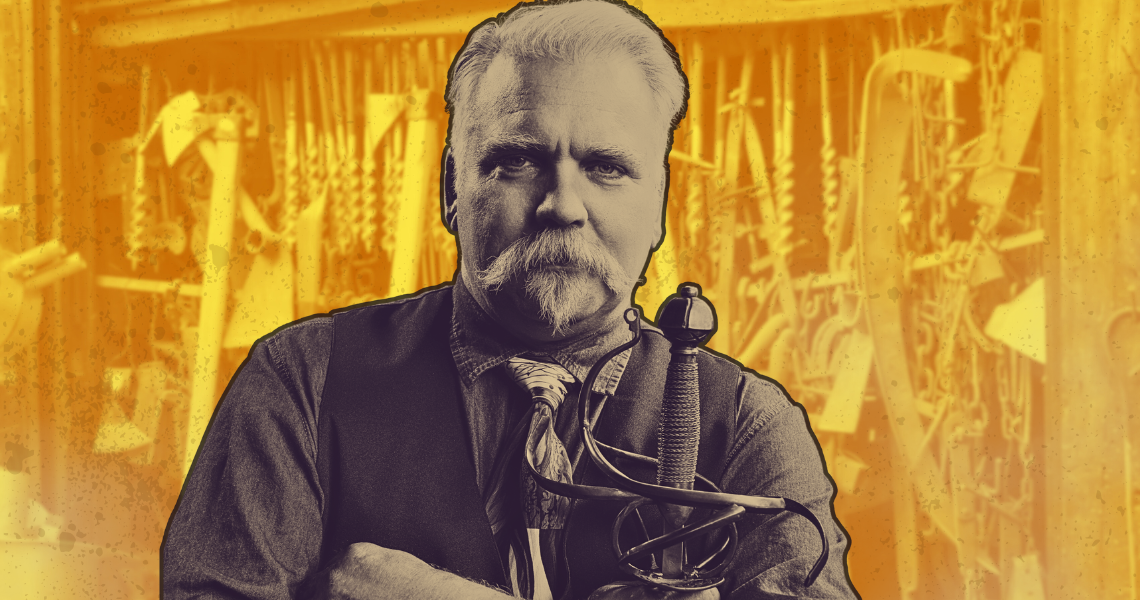Forging His Own Path: An Interview with Bladesmith David Roeder
(Image credit: David Roeder)
Today’s bladesmith interview is presented by our friends at Odenson.
David Roeder is a bladesmith out of Tri-Cities, Washington, and has had several television appearances on History. First, David was contacted to compete in Forged in Fire for the first season. Then, he returned as a fan favorite in season three, where he took home the title Forged in Fire Champion. The production team called him a third time to appear on Beat the Judges and yet again to compete in the short-lived series Knife or Death.
RELATED: WHEN WILL WE SEE FORGED IN FIRE SEASON 10?
David chatted with us about his multiple Forged in Fire experiences and what it was like to design and use his own blade on Knife or Death. He also talked about his foray into bladesmithing and what he has been up to lately.
David Roeder’s Bladesmithing Origin Story
BRUTE de FORGE: How did you get into forging and bladesmithing?
David Roeder: In 1996, I was sixteen years old and lived out in the country. I would go stump shooting after school, and over time I kept hearing this sound. I thought it was an anvil, but I wasn’t sure. Finally one day, I followed the sound, and I met a guy that, as it turned out, was not that far from where I lived. He had started forging a knife from a piece of coil spring, and I asked if he'd mind if I sat back and watched. I watched from the beginning to the end of that process and was hooked. I went back home and I did what I had to do to rig up my own stuff. I made my first one and I've been doing it ever since.
BDF: What is the name of your forge?
DR: I don't do names. I just use my name. So, it is David Roeder Knives.
BDF: That makes it easy for people. Would you say that you have a style to your knife making?
(Image credit: David Roeder)
DR: I can't necessarily claim a style. Not like Bill Moran or Steve Randall have a style. I can't say that I'm synonymous with something like that. I will say that it has been said over time that people can recognize my work without seeing my name on a blade. So, I can't say it's a style to claim, but I do have a look.
Life as a Journeyman Smith
BDF: You're a Journeyman Smith (JS). How's that been going for you? I always like to ask bladesmiths that are part of the ABS. I like hearing their reasonings and their stories. It seems like a complicated adventure, but ultimately worth it.
DR: Oh, it is going fine. It's no different from anything else. It's just quality accreditation, nothing major.
I used to spend a lot of time with the guy who got me going on this journey after I had gotten into this on my own. One of the things that we always talked about was a particular knife maker and how he made his knives. We idolized this one maker and the American Bladesmith Society. So, when I got old enough and better at my knife-making, I thought I better strive for that dream he and I always talked about. So that's why I’m doing it.
BDF: Do you have a lot of different bladesmiths that inspire you?
DR: There are a handful. The guy that got me going into this is obviously one I look to for guidance and to pitch ideas off. There are also a couple of the more prominent name makers like the Mastersmith that I associate with. So yeah, a small handful.
BDF: And the original gentleman you stumbled upon when you were following the sound of the anvil, does he still forge?
DR: Yes, he's still making knives. He was a retired corrections officer, so he plays in the fire and beats on steel all day now.
Why David enjoys bladesmithing
BDF: What is it about forging that you enjoy so much?
DR: Well, I was supposed to be a fourth-generation woodworker. My great-grandfather, my grandfather, and my dad—and what should have been me—did cabinet work, furniture building, and things of that nature. But I caught the metal bug.
“I love that aspect of knife-making and blacksmithing in general. Being able to make something usable and functional that you can work with.”
When I watched what that first bladesmith did, he was essentially making a tool. And it's a tool that not only can have an essence of quality but an essence of longevity. That tool, whether a knife, chisel, axe, or whatever it is, will be here far longer than any wooden chair or cabinet I could have ever made. I mean, that's the kind of stuff that people look at in the Smithsonian two hundred and fifty years later. I love that aspect of knife-making and blacksmithing in general. Being able to make something usable and functional that you can work with.
BDF: Do you have a favorite project that you've worked on?
DR: No one specific project. I did a couple of movie props for films. I've done knives for a couple of different celebrities. I've done some for different executives. I've also made some for independent contractors that have gone over to Afghanistan. I've done a lot, so I can't really point to one project specifically.
(Image credit: David Roeder/Klinker Forge Photography)
BDF: Can you reveal what movies?
DR: One is called Quail Hollow, but it's still in post-production. The production company won't release it. But the blade was a dagger. Then, the others were for a movie that's on Netflix Synchronic. In the opening part of the movie, there are three scenes where swords are displayed or used, and those are mine. It was cool to see it on the big screen.
BDF: You’ve got swords on the big screen, and you have made several appearances on TV shows. You were on Forged in Fire three times and on Knife or Death.
DR: Yeah, it was a ride. That’s how I refer to it.
Television comes calling David
BDF: How did you get to be on Forged in Fire the first time? That was season one.
DR: So, production did the pilot, and after a network accepted it, once they got a network to hook it, they reached out to me. They reached out to everyone on season one. So, they picked you if you were on the show for season one. None of us applied. So, they threw it out there to a bunch of different makers that they felt would fit their criteria, and I was one.
“You could smell the paint because they had just finished the night before. It was crazy.”
We filmed episode one, but they aired us as episode five. We were the first to be filmed during the series that year. When we started, the paint was still sticky on the floor and the equipment on the set. I mean, you could smell the paint because they had just finished the night before. It was crazy.
BDF: Were you hesitant at all when they reached out to you? Were you skeptical?
DR: I was apprehensive at first because I'd never heard of such a thing. But when the email and flight confirmation came through, I was like, “Well, why not?” It was a free trip to New York. If nothing else, I figured I could be a tourist in the Big Apple.
BDF: What was it like going into it blind? It's not like you had other seasons to compare it to. Did they give you a rundown of what was going to happen?
DR: They gave us an idea as to what they would like, but, realistically, the time was the makers. You could do whatever you wanted. They told us what we would have to do, but they didn't want to divulge too much. So honestly, we didn’t know much other than we would make a knife along with three other people.
We showed up, and they told us to stand here and don't talk and then look at the camera, and there was all this back and forth, and back and forth. Finally, they told us what we were doing. So we didn't know too much.
BDF: Did you know any of the other bladesmiths that were there for your episode?
DR: I knew the father of one of the guys that was there. But I didn't know the other two. I didn't know who would be there until we got into the car to film. At the hotel they put us up in, which was a real dive, there was a breakfast set up in the cafeteria. I was sitting there looking around, and I saw two other guys in work boots, and they also had work pants on. I said, “Hey, are you here for some silly TV show?” That's when I learned who else was there before we started the show.
We weren't supposed to know until we got to set, just in case we knew each other. They didn't want there to be any animosity or stress or anything like that. They wanted it all to be brand new.
BDF: Were you excited to be called back as a fan favorite for season three?
DR: Yeah, I thought that was neat. I was driving and got a call from someone in New York. I answered the phone, and some production assistant on the other end said, “I'm with Left Field Productions. We want to ask if you'd be interested in returning as a fan favorite.” I called my wife and asked, “Hey, you mind if I go back on Forged in Fire again?” She was excited and gave me her blessing, so I went back.
I came in second place the first time, and then on the second go around, I ended up winning it and becoming a Forged in Fire Champion.
BDF: Then you returned for the spin-off Beat the Judges? Did they call you for that, or was that something you applied for?
DR: No, they called me again. I can say with absolute confidence that for Forged in Fire, Beat the Judges, and Knife or Death, I never lifted a finger or expressed interest in those shows. They called me each time. I told them I would return for Beat the Judges, and they said it would be a little different this time. They explained the theme of the show, and it was totally different from the original one. It was a lot nicer for me to do it that time. I enjoyed myself, and I had fun. I was more relaxed.
BDF: Did you enjoy it more because of the format of it, or had you just gotten so comfortable by that point?
DR: Both, I think. I had already gotten comfortable with the cameras, but they gave me almost a month of preparation for Beat the Judges. They said to make anything I wanted, but it had to be bigger than what we did in other competitions. But I had a lot of time to be able to build what they wanted. It wasn't a time crunch. It was a lot more relaxing.
BDF: When they called you for Knife or Death, had you already seen season one? Did you know what you were getting into?
DR: No. I didn't really know what to expect there. When they called me, I knew there was a show, but I don't watch television. So, I knew that the show existed, but I had never watched it until they called me and pitched the idea. They gave me the show's concept, and I went back into season one and started watching all of them. That's how I came up with what I built. I based it on all of the problems I saw from season one.
BDF: I wanted to ask how you decided which style and design to go with.
DR: In retrospect, I should have gone with a slightly longer handle, but I knew I wanted a recurve in the blade. I didn’t want something atrociously long, so I condensed it to a recurve camp knife.
BDF: Was it fun? Because it looks fun.
DR: Oh, yeah! As a knife maker or a bladesmith, you make your product, and it goes out the door in the world. The buyer uses it and does what they do with that. Sometimes you get feedback, but you don’t actually get to play with it yourself much. This show gave me an opportunity to build something and not only play with it but push it to the extreme. So that was incredibly fun.
When it was over, the host said, “Hey, you did pretty well. How much experience in this do you have?” I told him it was my first day. So that question backfired on him.
David’s current work
BDF: What have you been up to then lately?
DR: Well, I moved from where I was to Tacoma, Washington, back to Tri-Cities, Washington, where I came from initially. So, I'm going to be picking things up back where I was in the beginning. I'll be doing classes again as well.
BDF: What kind of classes do you typically offer?
(Image credit: David Roeder)
DR: They are mostly forging classes. We do a brute de forge style or, if it's a timelier type of a class, I offer a hunter style. The brutes are the most popular because they're the shorter, more condensed classes. I'll also occasionally do railroad spike knife classes, but those aren't usually really nice. Those are more novelty items.
BDF: Do you have any advice for aspiring bladesmiths?
DR: I get that question a lot. Here’s the simple answer. One, get a job. Being a full-time bladesmith and making money to survive right out of the gates isn’t going to happen. You're going to starve. The other part is practice, practice, practice! Practice makes perfect. Not every knife is going to be great, but, over time, with enough under your belt, you'll get there. Be patient.
To see more of David’s work, visit his Facebook pages at Custom Knives by David Roeder JS or Instagram at davidroederknives.
About The Author
More Interviews






















